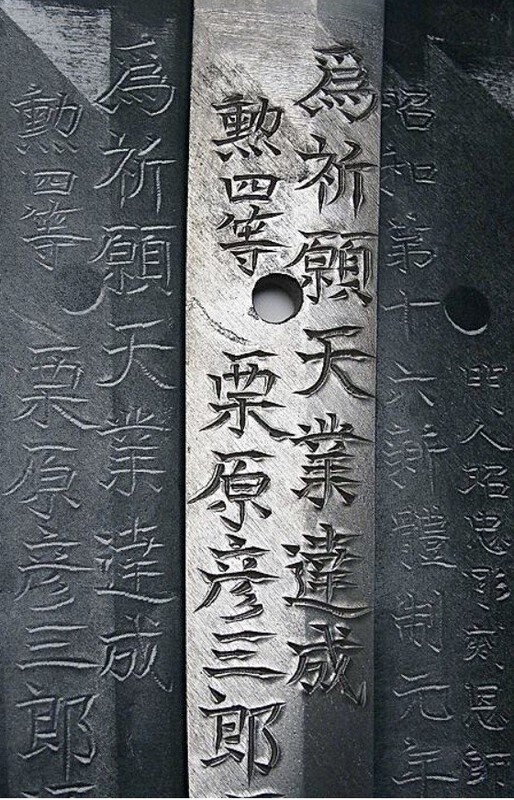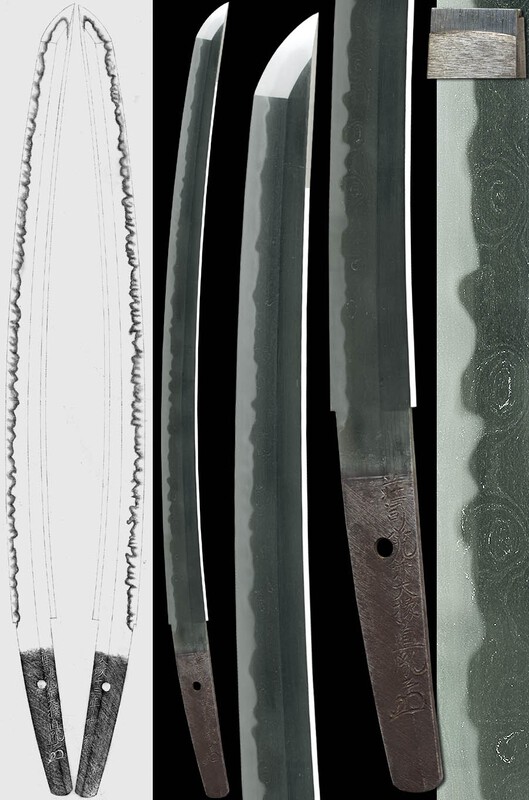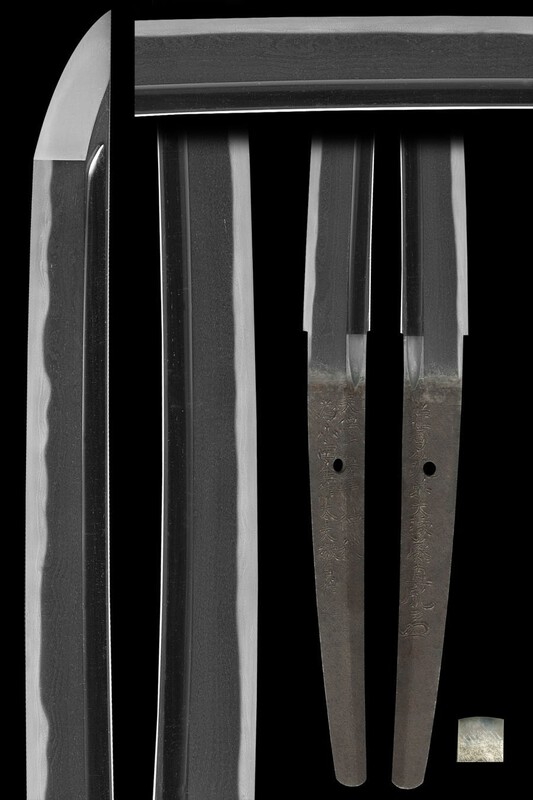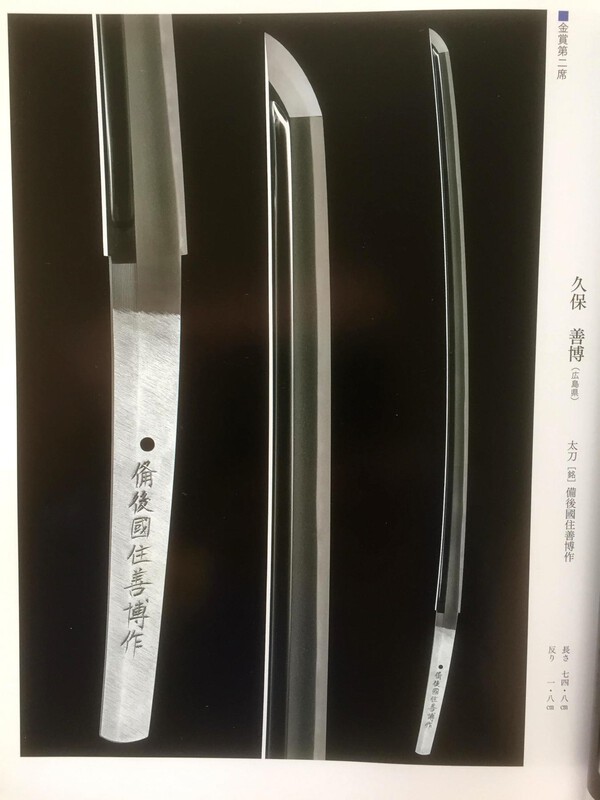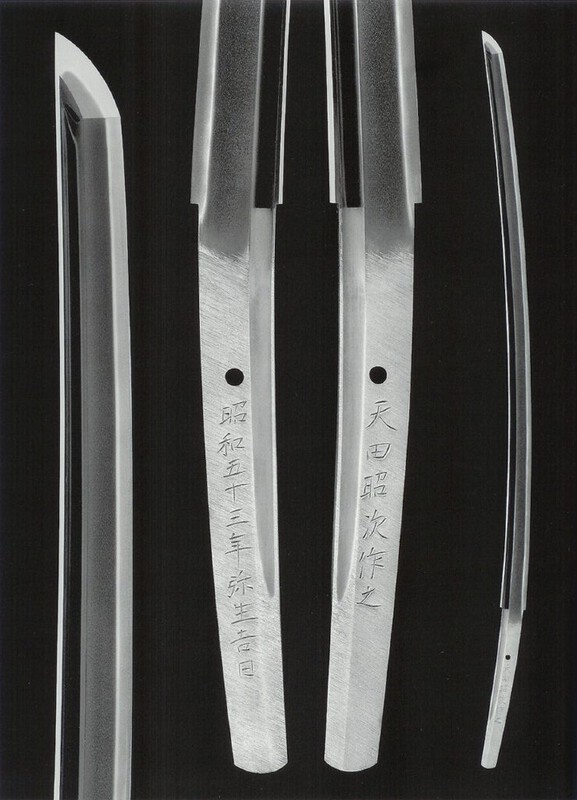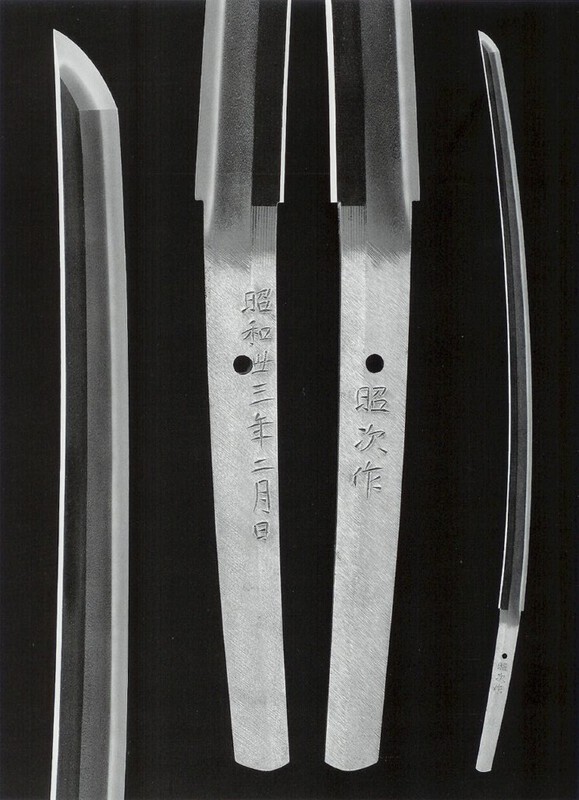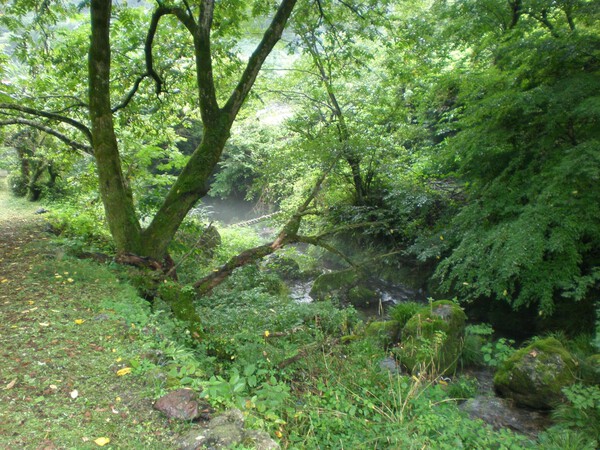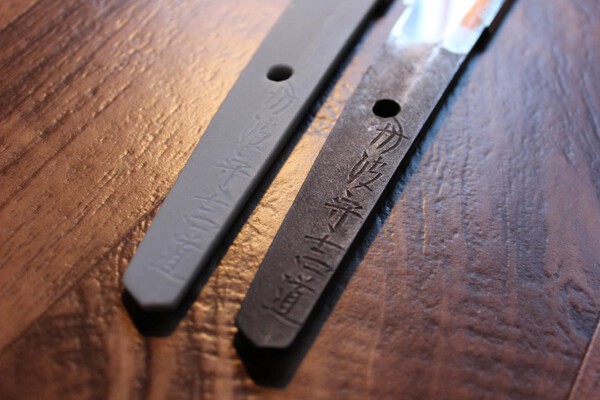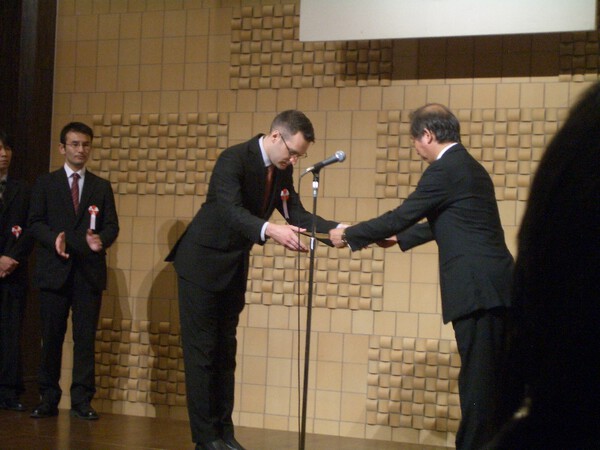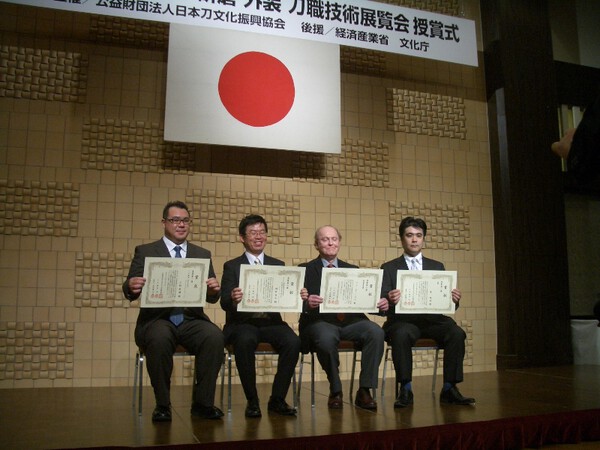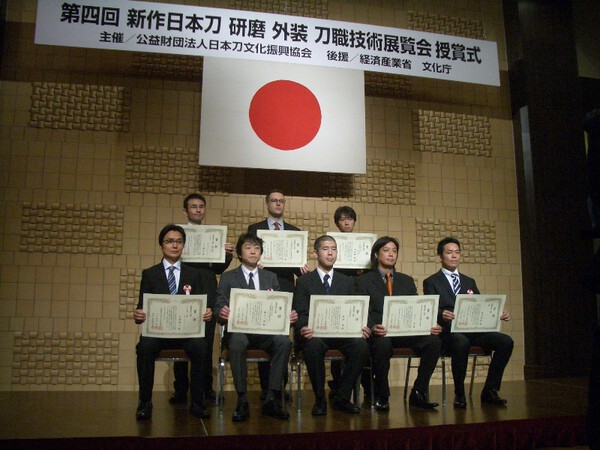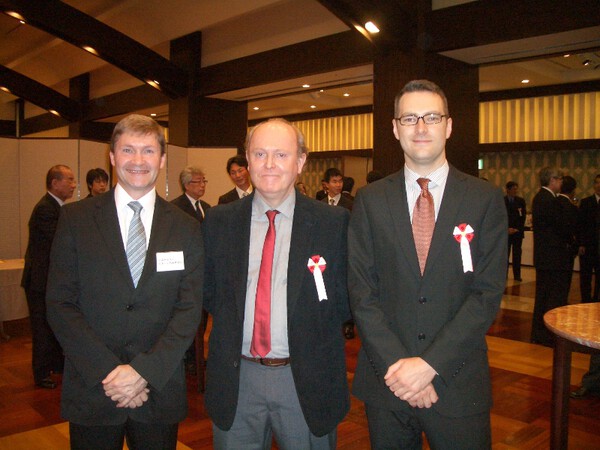-
Posts
65 -
Joined
-
Days Won
7
Everything posted by Andrew Ickeringill
-
Yes, there are many differences in the horimono both in terms of style and quality which raise suspicion… actually, a huge gap in quality! As well as many differences in the deki of the sword, which wouldn’t be so if it were a shadow sword made at the same time as the original by Akihide. But to me, the big giveaway is with the nakago. The original has some minor openings in the nakago just to the left of the mekugi-ana which appear as a sort of scarring, the faker has attempted to reproduce this scarred effect in their sword, but the angles are incorrect, it goes off in a different direction. Which logically points to the 2nd sword being an attempt at a direct fake, rather than a shadow sword by Akihide. (Original to the left, fake in the middle) Once this is clear, and you start to really analyse the tagane and yasurime, the differences start to jump out at you. No sword should be assumed shoshin simply because of the supposed period or maker, wherever there’s money to be made, there are fakes to be made.
-
I believe these two swords have been discussed before in one of the FB groups, the topic was raised by Chris Bowen. They’re actually both dated 1941, in fact the inscriptions are exactly the same on both swords, though clearly made by different hands. The one with the hozon paper is of course legitimate and quite a well-known sword by Akihide, the other is an elaborate fake, so maybe not congratulations, but commiserations to the buyer
-
To clarify further tsukurigane 作り鉄 (literal translation = made steel) is a forging process that involves mixing steels of varying carbon content in order to produce a chikei-like effect in the jigane. If you’re after a more definitive translation, I don’t really have one, but it seems the term is used for any kind of jigane that contains chikei that weren’t formed “naturally” in the forging process, such as ayasugi-hada, uzumaki-hada, the imozuru found in satsumato or the matsukawa-hada of Hankei. So, perhaps the closest translation is ‘unnatural steel’? But to me, that’s not a very flattering definition, especially when looking at the incredibly beautiful results of this technique when performed by a master. I’ve also heard the term mazegane 混ぜ鉄 (literal translation = mixed steel) used to describe the same or similar process. I’ve heard some craftsmen use the terms tsukurigane and mazegane interchangeably, while I’ve heard other craftsmen separate these two terms as slightly different, based on the materials used I believe. I think it depends who you ask and their school of swordmaking, but I’ve not seen these terms explained before in text, only heard them in conversation, so it’s difficult to nail down exact definitions/translations. You could call tsukurigane and mazegane both 'mixed steel' and you'd be correct, yet to some craftsmen there are differences. Hope that helps somewhat.
- 104 replies
-
- 12
-

-
I wouldn't say a position of knowledge Brian, but maybe a little further insight, but thanks for allowing me to post because this was an interesting topic, too bad it branched off into the absurd… let’s see if we can bring it back on course a little. I’ve been lucky enough to polish a couple Naotane in my time, and I feel I have some understanding of his work. I’ve been even luckier to have had many discussions with people who know far more than I do about forging techniques, and I believe one particular technique I’ve learnt about has some relation to this discussion. Naotane was a master of the shinshinto period who was able to produce incredible work in many different styles. There were of course several smiths of this period who skilfully produced swords in different styles of the gokaden… but Naotane was able to produce several different sub-styles within each of the gokaden in which he worked, but rather than just changing the type of hamon, he used completely different forging techniques, which is where his genius lies for me. For example, just in his Bizen-den alone I’ve seen several different approaches used: - He made Kagemitsu and Oei-Bizen utsushi using typical forging techniques and tsuchioke to create a more controlled yakiba and utsuri on a ko-itame hada. - He occasionally used a mixed hada in his Kagemitsu utsushi, with a flowing chikei mixed in with ko-itame hada. - Sometimes he made a pronounced uzumaki-hada in his Bizen-den, which I’ve heard as being a kantei point of his, though I’ve not often seen it. - And rarely, he made Bizen utsushi using hadaka-yaki to produce more wild yakiba and stronger utsuri formations. Naotane’s Uzumaki-hada in Bizen-den. I’ve also seen him create Yamato-den with thick bands of masame-hada, and Soshu-den with swirls and burls of chikei similar to Matsukawa-hada… the point is, he was probably the most versatile smith of the shinshinto period, especially when it came to creating different jigane. During a time when many smiths produced very tight hada, sometimes even muji-like hada, Naotane was forging masterful steel with flowing chikei and utsuri. One of the techniques he mastered in order to achieve this variety of steel was called tsukurigane, it’s a term I came across early in my polishing apprenticeship, and I’ve not seen it mentioned in any texts that I can recall. It was explained to me as a way of forging steel that reliably produces a clear and controlled ‘chikei-like effect’ which several modern-day makers were using in their Soshu-den utsushi. But, it’s not the way chikei was typically created in koto work, except for a few schools such as the Norishige school, who I believe used some form of tsukurigane, but that’s a completely different rabbit-hole and a completely different level of genius! Tsukurigane (‘tsukuri’ generally translates as ‘making’ or ‘to make’ or relates to a particular technique of manufacture such as ‘shinogi-zukuri’, but in this case I believe ‘tsukuri’ infers a meaning of the steel being controlled or contrived). It’s a type of kawagane which is made by forging together two or more different billets of steel, often forging them together using a relatively low number of folds. The different billets used in the process can each be folded in the same pattern (e.g. ko-tame) and can be of the same number of folds, so when they’re combined, there’s no discernible difference between them in terms of the pattern or the fineness/tightness of the grain. But, these different billets usually have vastly varying carbon content, which means once polished they’ll produce different colours and textures, and different amounts of ji-nie, which is what creates the chikei effect running through the jigane. The less you fold these billets together to combine them, the larger the chikei pattern it’ll create, and the larger the difference in carbon content, the more contrast there’ll be in the chikei. Apparently, combining them using limited folds, but without producing kitae-ware is extremely difficult, but when done masterfully as Naotane was able to achieve, it can create a very beautiful chikei effect flowing through the jigane. Naotane’s tsukurigane producing a masame/mokume mixed effect. I once opened a window on a Naotane that was in Bizen-den and was a great example of tsukurigane. Something I found fascinating was, once I’d brought out the jigane, on some angles it would appear as a very tight ko-itame with only a hint of chikei in the background, while on other angles swirling chikei would jump to the surface and completely change the overall impression of the steel. It was a brilliant effect that gave the steel a lot of depth, and it made me think about how different a sword can look on different angles or under different lights. Of course, the polish makes a huge difference as well, the previous polish was acid-etched and gave the steel a damascus-like effect. These two pics are of the Naotane I just described, as you can see one shows a tight ko-itame, and the other shows a flowing chikei effect running through it. But the pics are of the exact same section of steel, at the same point of the polishing process, under the same light, in the same room… just on different angles. I believe all of the above relates to the juyo katana which started this discussion… I definitely see tsukurigane in this sword, which is creating a lot of chikei, but I’m not sure I specifically see mokume-hada or uzumaki-hada. There are definitely some patterns which hint at something reminiscent of mokume, but I don’t think they’re actually forming a proper burl pattern, it seems that they’re a sort of wavy/churning chikei effect, so personally I don’t think I’d call it mokume. Either way, the chikei created by this style of forging can exist within a tight ko-itame, so even if there were mokume or uzumaki patterns in the chikei, I could understand the NBTHK defining it as ko-itame. It’s not easy sometimes to define a hada, for me, the strength and clarity of which a pattern appears, and how often it occurs over the whole sword are big factors in defining it, and I imagine those are also factors in determining whether or not it’s mentioned in an NBTHK setsumei. But I’m no expert, and I haven’t seen this sword in hand, which is really important as pictures can be misleading, as I mentioned above, a slight change in light or angle can completely change the appearance of certain types of jigane. The NBTHK on the other hand are experts, and have seen the sword in hand, in fact they’ve studied it at length as they’ve passed it as juyo. So, I think the point that Jacques is trying to make is valid, they’ve not mentioned mokume or uzumaki in their setsumei, so one can fairly surmise that there isn’t any in the forging. I will say though, there are perhaps better ways of trying to get your point across, and the discussion would’ve been better off if its contributors were maybe more considerate. Perhaps there are language barriers, or things are being misconstrued as they often can be over emails and forum posts, either way an interesting discussion that merits more thought. That’s just my 2 cents.
- 104 replies
-
- 21
-

-

-

-
Yes, quite often, to varying degrees, most of the time the difference is negligible and it would go unnoticed by most people.
-
The first time I ever performed hi-togi during my apprenticeship, I asked my sensei the same question. He explained that sometimes the asymmetry in the hi-saki is done deliberately, as ending the hi on both sides in the exact same spot can create a weak point in the kissaki, which puts that area at higher risk of taking fatal damage during use. However, he added that not all hi are carved with this in mind, and some asymmetry you see here could’ve been caused by polishing, but polishing alone doesn’t account for all cases. The same explanation was given to me by a mukansa-ranked tosho, who occasionally used this technique, depending on the dimensions of the blade.
- 11 replies
-
- 12
-

-

-

A word about amateur polishing
Andrew Ickeringill replied to Brian's topic in General Nihonto Related Discussion
The most basic requirement is to put in the necessary effort yourself. -
Hi James, yes there are many examples of hadaka-yaki being executed to an extreme degree of skill in the Ichimonji school. However, the craftsmen I mentioned were referring to more recent attempts at hadaka-yaki (shinshinto – gendaito). I thought this was inferred by your original question “modern smiths have yet to rediscover "true" utsuri” but reading my post back I don’t think I was clear in this point. These two different heat treatment methods can produce very different results with utsuri, and while I don’t necessarily agree with the view that one method is better than the other, I do understand that some craftsmen may prefer one method over the other. From my own perspective, I’d say that just like every other feature of Nihonto, not all utsuri is created equal. Being able to judge the quality of the activities in the steel is a large part of judging the quality of a Japanese sword. To me this has less to do with the methods used to create the sword, and more to do with the degree of skill and experience that went into these methods. But I’ll add that these views were shared with me by senior craftsmen who I respect, some of whom have dedicated their lives to reproducing Bizen style swords, so I wouldn’t dare assume I know more than them on the subject. What is for sure in this field of study is… the more we learn, the more we realise we have more to learn!
-
What is "true" utsuri? What isn't? The question in this thread could be interpreted in different ways, I believe James is probably referring to hadaka-yaki, but I'll touch on a few different things that come to mind. 1) Yes, there are swords on the market (particularly coming from Japanese auction sites) that have fake utsuri. It’s a chemical technique applied to the blade in the polishing process, which is designed to resemble utsuri on certain angles. However, the examples I’ve seen have been rather crude and obvious, and can easily be detected through pictures. I’d also like to make clear that this technique is not being applied by traditionally trained togishi, I’ve only ever seen it on blades that were defiled by hobby-polishers/self-taught hacks. If you want more info on how to spot fake utsuri, please read the following link: https://www.facebook.com/toukentogishi/posts/2401556073244615 If you don’t do facebook, it was also posted on NMB: https://www.militaria.co.za/nmb/topic/28800-warning-about-fake-utsuri/?tab=comments#comment-291807 2) There is another type of fake utsuri that appears in Nihonto, though you wouldn’t really refer to it as fake, as it’s very much a naturally occurring effect, not an artificial effect applied in the polish. It’s called tsukare-utsuri. Tsukare-utsuri literally translates as ‘tired utsuri’ and it occurs when shingane (core steel) is exposed. More often than not it can be found in lower-quality work of the Muromachi period (known as kazu-uchimono) which is known to have especially thin kawagane (skin steel). Tsukare-utsuri forms a loose/hazy utsuri-like effect in the steel that… - sometimes appears only around the border of where kawagane becomes shingane. - sometimes it completely fills that area of shingane. - or sometimes appears in patches within that area of shingane. In any case, it doesn’t look very appealing, it's definitely not a desirable trait in a sword, and you should be able to recognise it as something other than "true" utsuri. 3) Then there is the question around hadaka-yaki (heat treatment without clay) which is most likely what the question in this thread is about. During my training I was lucky enough to have quite a few conversations regarding utsuri with other craftsmen, and I get the impression that some of them believe that the utsuri produced when hadaka-yaki is performed on a blade is not really considered “true” utsuri. I recall one such conversation with several togishi at NBTHK kantei-kai. There was an exceptional Naotane which had very strong utsuri, and I was keen to understand why it was so much stronger than utsuri I’d seen in his work before. It was explained to me that “yes, this utsuri appears strong, but… this is only hadaka-yaki, and Naotane rarely used this technique”… implying that hadaka-yaki was a lesser way of achieving utsuri. I’ve heard similar remarks from tosho who work at producing utsuri when using tsuchi-oke (applying clay for heat treatment). Apparently, producing a clearly visible utsuri on a consistent basis is more easily achieved when using hadaka-yaki, but that type of utsuri can often appear wild and unrefined. So it's viewed by some as a greater achievement to produce prominent utsuri using tsuchi-oke. It’s a fascinating topic that deserves further study and debate, but I won’t wade into those depths today. I will say however that from recent efforts I've seen, it seems modern tosho are continuing to advance their abilities and re-discover the "secrets" of utsuri using both methods. Lastly, I’ll add a little article I posted a while ago, it’s a beginner’s guide to utsuri that should give you a little more info and some instruction on how to view it properly: https://www.facebook.com/toukentogishi/posts/1109394242460811?__cft__[0]=AZX5euUw0LcK-KtWaluQagI_Mp3mJ_MjHaxXY3D8nwx2FUANlNbxuChojfhd7LXkGKTJPIQa53xCp92Q9iuUGaQhj2gI1DAz03C4pGBNqEbXGglfyD-a1360xzhwIr8ZhQmn_ljmPPS351Mu31OHJynoJNKq8gQFGloA9qcDyRHbbp6-yAOqH73jfStPElKolfI&__tn__=%2CO%2CP-R
-

Can modern smiths create a vibrant utsuri like in ko-Bizen blades?
Andrew Ickeringill replied to piryohae3's topic in Nihonto
But I should add that none of these smiths can produce utsuri like that of the Ko-Bizen smiths!! Or any school from the Heian - Early Muromachi period for that matter!! -

Can modern smiths create a vibrant utsuri like in ko-Bizen blades?
Andrew Ickeringill replied to piryohae3's topic in Nihonto
Shinto – Ishido school – particularly Korekazu and Tatara Nagayuki Shinshinto – Naotane, Soukan Shinsakuto – Kawachi Kunihira, Yoshihara school - particularly Kubo Yoshihiro Basically, there were relatively few smiths in these periods that were able to produce strong utsuri consistently. You can find utsuri occasionally in the works of other smiths not mentioned above, but being able to produce deliberate utsuri of consistent quality is a whole different matter! Another thing to consider, many tosho of the Shinto period were striving to create new styles (Shinto Tokuden) and weren't so focused on reproducing the work of earlier schools. For example, Tsuda Echizen Sukehiro was a master of the Shinto period, and was fully capable of producing utsuri, but he's not known for it, it's not a kantei point, because you won't find it in his blades with toranba which is what he's most known for. But he also made Yamashiro-den utsushi in suguha, which often have utsuri, sometimes of phenomenal quality. For modern tosho I make special mention of Kawachi Kunihira and Kubo Yoshihiro... A few years back, I was able to view the sword that won Kawachi Kunihira the Masamune-sho, for me it was probably the best Bizen utsushi I’ve seen of the last 100 years, the utsuri was outstanding! As for Kubo Yoshihiro, his Aoe school utsushi have very nice consistent utsuri, even on his suguha tachi, which is a real achievement as this technique doesn’t involve hadaka-yaki. Here are a couple pics (sorry for poor quality, taken on my phone) of Kubo Yoshihiro’s work and a link to a doco featuring him and his deshi: https://www.youtube.com/watch?v=0glduW4-EPY&fbclid=IwAR39oFJLHEcqzMzmNrHz5OTuQFZsAV70gUhsXoPidDQeWnvbPqOZrRret4s -
As you've already realised, Bizen-den and Soshu-den are by far the most popular styles being made by modern tosho. Other popular styles are Kiyomaro and Sukehiro utsushi. Those working in Yamashiro-den, Yamato-den or Mino-den are few and far between. Yamashiro-den: Amata Akitsugu was definitely the best I’ve seen to have worked in Yamashiro-den in modern times (attached are a couple examples of his work in this style), though he was also excellent in Bizen-den and Soshu-den as well. Unfortunately he passed away a few years back and I don’t think his students work in Yamashiro-den. I can’t think of any other smiths off the top of my head who are currently working in Yamashiro-den, but if you go back to Gendaito you have the Yasukuni group of smiths who focused mainly on reproducing the work of the Kamakura Rai school. Yamato-den: The modern Gassan line often work in Yamato-den, occasionally forging blades in pure masame-hada which are aimed at the Yamato Hosho school. And of course, their ayasugi-hada is a technique that was also produced by the original Gassan school of the koto period, which was a Yamato-den school. Mino-den: You’ll find that the modern smiths who are working in Mino-den are usually reproducing the style of Shizu Kaneuji. Though a lot of these utsushi are perhaps closer to Soshu-den than Mino-den, Kaneuji being a smith who started the Mino tradition but whose work was strongly influenced by Soshu-den. You won’t find a whole lot of sanbonsugi these days! ???? The Kanefusa line are still producing swords in Gifu I believe, the current head of the school is the 24th or 25th gen and his Kaneuji utsushi are excellent.
- 9 replies
-
- 10
-

-

Shinto Suriage Tbh?
Andrew Ickeringill replied to TheGermanBastard's topic in Auctions and Online Sales or Sellers
In the world of Nihonto, there are always surprises and exceptions to the "rules"... http://www.nipponto.co.jp/swords3/KT324507.htm -

Best Post Ww2 Smith?
Andrew Ickeringill replied to barnejp's topic in General Nihonto Related Discussion
Hi Joe, that's a good group of names on your list for sure. Yes you're correct Ozawa Masatoshi didn't make Mukansa, that was an error in my original post, also I forgot that Kubo Yoshihiro actually did make Mukansa just last year, I've edited my original post to reflect this. For those interested, here's a handy link listing every Mukansa, Ningen Kokuho and Masamune-sho winners - http://www.tsuruginoya.com/mn1_6/mn6_5_17.html I included Ozawa sensei on my list mainly because of 2 particular swords, a Go utsushi which was possibly the best modern Soshu-den work I've seen, and the other a kogarasu-maru utsushi which was possibly the best modern work I've seen, period. Ozawa sensei passed away before my time, but I know his son Toshihisa who's also an accomplished tosho. We were once invited for a bbq at their family home and forge, maybe the most serene location I've ever been, middle of the mountains, right next to a river, the sake flowed much faster than the river though, was a great day! (I've attached a couple pics from the day) By the way Joe, Takehana san was one of the tosho that would send his competition entries to my sensei, so I got to work on some of his best. They were very much like the following examples with rather elaborate ryu horimono that he'd carved himself - http://katana.art.coocan.jp/Riyu/Riyu.html#2012ryu-daisyou and from memory he won some top prizes in those days, but I haven't seen or heard anything from him in a while. -

Best Post Ww2 Smith?
Andrew Ickeringill replied to barnejp's topic in General Nihonto Related Discussion
Cheers Brian, yes it was unbelievable being able to work on swords by master tosho from all periods during my training, but when working on shinsakuto there was an added connection, the fact that I could talk to that tosho! I was getting info on forging techniques, hearing great stories and visiting forges to watch them work... it all adds to appreciating the swords they produced. I'm very thankful for these experiences. Hi Rayhan, of course they're good, to reach mukansa such as Sadatoshi has done you have to be better than good! And the Gassan line is in very capable hands with the next generation as well - Sadanobu the son of Sadatoshi. There are many good or great post WWII tosho that I didn't mention above. The tosho I did mention are the ones that stand out from everything I've seen, some of them for consistent excellent work and others for particular swords that were truly exceptional, or both. Ranking tosho of a particular period is very difficult and something I normally wouldn't attempt but I did so here because I felt it was an area of study that most western collectors don't bother with, and maybe by giving some names and links to swords it would spark an interest in further study from some members here. -

Best Post Ww2 Smith?
Andrew Ickeringill replied to barnejp's topic in General Nihonto Related Discussion
This is an interesting topic, and probably a topic that some western collectors aren't that familiar with. But it's something worth investigating, you may be shocked with some of the high level of work that's been created since WWII. I'm going to take this thread as meaning who were the best tosho during this period, not the most famous, as they're two very different things. I probably have a rather unique view of this period, during my time in Japan I got to work on swords by Miyairi Yukihira, Amata Akitsugu, Sumitani Masamine, Gassan Sadaichi, Gassan Sadakatsu, Tsukamoto Okimasa, Tanigawa Moriyoshi, Yoshihara Shoji, Kanbayashi Tsunehira, Ozawa Masatoshi... to name a few. And even though I've seen a good number of gendaito and shinsakuto, I haven't seen them all, so of course this is just my opinion, based on the best works I recall by these tosho and trying to objectively judge on quality rather than personal taste. For me the best tosho since WWII in no particular order are: - Amata Akitsugu: Ningen Kokuho, he worked in Bizen, Soshu & Yamashiro-den, and was excellent in all of these traditions, a genius tosho. Even in his final years he was still making his own oroshigane and experimenting in new forging techniques. He passed away 5 years ago but already his work is reaching Tokubetsu Hozon level - http://iidakoendo.com/6200/ (click on the blue numbers) - http://www.katana-Japan.com/?page_id=27 - Sumitani Masamine: Ningen Kokuho, Bizen-den, his chojiba became famous for it's thick nioi-guchi, with nie & nioi filling the entire yakiba all the way to the hasaki. https://www.aoijapan.net/katana-sanryu-masamine/ - Kawachi Kunihira: Mukansa, Bizen-den & Soshu-den, a few years ago I got to see the sword he won the Masamune-sho with, it was one of the best shinsakuto I've ever seen. http://kako.nipponto.co.jp/swords/KT118748.htm http://kako.nipponto.co.jp/swords2/KT218582.htm - Ozawa Masatoshi: Soshu-den, probably unknown to most western collectors, he has made some modern-day masterpieces. https://www.aoijapan.net/dai-sho-shomaru-toge-ju-ozawa-masatoshi-saku/ - Ono Yoshimitsu: Mukansa, Bizen-den, we've all seen his Yamatorige utsushimono, the clarity and control he achieves in his chojiba is incredible. https://yuhindo.com/ono-yoshimitsu-daisho/ - Tanigawa Moriyoshi: Mukansa, mainly Kiyomaro utsushimono, he was so passionate about his work he would often sleep next to his favourite swords, bare blades straight from the forge! https://www.seiyudo.com/541.htm - Kubo Yoshihiro: Mukansa, he's currently producing some fantastic Aoe utsushimono, probably the best/most consistent utsuri I've seen on anything in the last 100 years. Cheers.- 23 replies
-
- 16
-

-

-

3D Printing For Saya And Habaki Work
Andrew Ickeringill replied to Brian's topic in General Nihonto Related Discussion
Hi Piers, the sword in the middle is the first attempt at printing, which was a fail on almost every level. The print at the top is the one I sent to Japan to have habaki and shirasaya made, this one was much better but not perfect, still some work to do. Actually John, a great level of detail is required if habaki and saya are being made from it, especially important is the detail in the nakago. You can see below the level of detail is quite high, you can actually run your finger across the nakago and feel the yasurime. This is true, at the moment the level of detail required might not be possible with home printers, but it won't be long. There's some more info and pics here if you're interested - https://www.facebook.com/toukentogishi/ Cheers. -
You guys should be looking more towards...
-

On NHK tomorrow
Andrew Ickeringill replied to Ian's topic in Sword Shows, Events, Community News and Legislation Issues
Brian, from memory there are usually around 35-40 entries into the polishing comp, but these include a few entries submitted by the judges of the comp which you could say is the equivalent of mukansa, meaning these craftsmen are no longer eligible to win a prize, they're considered above judgement. The polishing comp has the most number of entries each year. Only 1 entry per person of course, any sword that is real Nihonto can be entered, it's a personal choice. -

On NHK tomorrow
Andrew Ickeringill replied to Ian's topic in Sword Shows, Events, Community News and Legislation Issues
Brian, many thanks for the kind words, I'll keep everyone posted. Kevin, this is how it goes with the competitions... NBSK - The categories are polishing, sword-making, tsuba, habaki, shirasaya, tsukamaki and sometimes lacquerwork. More prizes are given out in the categories of polishing and sword-making as there are many more entries. The below examples are for polishing and sword-making, so for the other categories it's the same ranking, just fewer prizes given out. Toku-sho - 1 to 2 prizes are given out to the top entries, in some categories they may not award a tokusho. Kin-sho - The next highest prize, 3 to 4 prizes are given out. Gin-sho - 4 to 5 prizes are given out. Dou-sho - 5 to 6 prizes are given out. Nyusen - Runner up, accepted into the competition but didn't receive a top prize. Rakusen - Not accepted. NBTHK - It's slightly different, they have the same categories, but the prizes have different names and sometimes they give out more prizes overall. However like the NBSK, there are some categories in which fewer prizes are awarded due to lower number of entries. Toku-sho - 3 to 5 prizes are given out to the top entries, in some categories they may not award a tokusho. Yushu-sho - 3 to 5 prizes are given out. Doryoku-sho - 7 to 10 prizes are given out. Nyusen - Runner up accepted into the competition but didn't receive a top prize. Rakusen - Not accepted. ---------------------------------------------- So as far as ranking is concerned, to give an example, in my case I took the 3rd place Kin-sho in last years NBSK comp, last year they only gave out one Toku-sho for polishing, so overall I ranked 4th in the polishing category. This might've been called Toku-sho in the NBTHK comp depending on how many they gave out that year... but that wouldn't change the rank, it's just the name of the prize they'd give to overall 4th place. Hope that clears it up. I think I've confused myself though :? -

On NHK tomorrow
Andrew Ickeringill replied to Ian's topic in Sword Shows, Events, Community News and Legislation Issues
I'm very pleased to see the responses so far from people who have enjoyed this documentary!! Both NHK and my sensei certainly put a lot of effort into it, looks like the effort payed off. As Ford has stated, this doco was originally going to be based around my apprenticeship with sensei, but unfortunately I couldn't be there at the time of filming. So the exec producer of the doco re-hashed the whole thing to be about the other students entering the competition, and what a great result!! I think they did a great job capturing the characters of sensei and the lads in the house and the relationships they have with each other, this is something I've never really seen portrayed in a documentary before, a rare glimpse. After all, this is one of the keys of being an uchideshi, if you don't respect and get along with your sensei or sempai, you're not going to last long. It's like a family, and although there are strong rivalries involved it's important to have that comradery, a brotherhood. So well done to everyone involved!! Now, as for me finishing my training and setting up my workshop, I may have to open another thread... stay tuned. -
Just a quick update... The award ceremony took place on Saturday 8th at The Okura Hotel, opposite The Okura Museum of Art where the competition exhibition is being held (until July 28th). It was a great day, with plenty of anticipation and tension buzzing about. Stepping up to receive my gold prize I felt ok, but was later told I looked like a nervous wreck!! Ford being an old pro at accepting gold prizes had no problems at all!! Afterwards we all went over to view the exhibition, it didn't disappoint. Once again they have put on an excellent display, the standard of work for this years competition was superb as always. After the exhibition, the most important part... the izakaya!! Unfortunately photos are not supposed to be taken in the museum so there are no pics of the exhibition, but I have attached some pics of the ceremony for you all. Cheers.
-
Thanks everyone for your comments, it’s fantastic to receive all this encouragement!! Thanks especially to Ford for posting this thread and sharing the good news, I appreciate the support a great deal. And congratulations to Ford for his gold prize (again!), a truly remarkable effort!! Your skill and decades of hard work is evident in your tsuba for all to see, a modern day master. Also congrats to Cameron Appleford on receiving nyusen for his habaki. I met Kam at the Sydney shinsa and he impressed me with how eager he was to learn, so I offered to help him organize some training in Japan. He came to the NBSK sword craft workshop last year in Nagano where he was guided by the very best sayashi and shiroganeshi in Japan, he also studied habaki privately under a very skilled craftsman and friend of mine. Kam has improved his skills a great deal and shows the hunger to continue to do so, well done!! There may be a lot of people on this forum who do not know of me, that’s completely understandable considering I haven’t posted in years, however I’ve been a member since the early days when Rich Turner was running the site. My training here in Japan keeps me incredibly busy which is why I don’t get a chance to post on the forum, but I do sometimes have a little look, credit to Brian for running it so well, it can’t be easy!! Anyway, just a brief intro… I’ve been serving in a traditional apprenticeship under Sasaki Takushi for 5 years now, based in Misato, Saitama. I am part of the Nagayama Kokan branch of the Honami tradition, my sensei served as an apprentice to Nagayama Kokan who was a living national treasure togishi. For those asking for pics of the prize winning sword, you will have to wait until the exhibition catalogue is released unfortunately. The NBSK may upload the catalogue images on their website, I’m not sure. I didn't think to take any pics of the blade myself before I submitted it, but maybe I can take some after the exhibition if I get a chance. The pictures above posted by Adrian are from a wakizashi I polished over a year ago, a friend here in Japan had found the sword in the wall behind the family shrine in his house. It was badly rusted and completely bent out of shape. It's not what we would consider an art sword, however it held deep sentimental value to the family and so my sensei allowed me to take it on. It's mumei, late shinshinto, a low-rank smith, possibly made as a boys day sword, basically wakimono but it shows traits similar to Bungo Takada. It came out very well considering the condition it was previously in, and the fact that it’s not a high quality sword, the steel is weak and the hamon dull, however a good polish can work wonders!! Anyways, I do hope to be able to post here more often in the future, I will continue to drop in whenever I can, thanks again everybody!! Oh and FYI, the NBSK competition exhibition will be held at the Okura Museum of Art in Tokyo June 8th – July 28th, it’s well worth a visit, please stop by!!
-
For anyone considering going to this event, there will be demonstrations by craftsmen on the balcony of the museum June 26th and July 10th 1pm – 4:30pm. There will be polishing, saya making, habaki making and tsuba making I believe. I will be there on both days helping out with the polishing demonstrations, though I don’t know if I’ll actually be doing the polishing as I did last year, or just giving English translations, either way it would be good to meet some board members. Also, I’d like to point out that this exhibition isn’t just modern made pieces, you will see great swords from all periods on display submitted for the polishing competition. This year there are many highlights, Rai Kuniyuki, Rai Kunitoshi, Norishige, Ko-bizen Sukekane and many more. So, perhaps I will see some of you Tokyo guys there?
-

Where do Australian Collectors get thier swords polished?
Andrew Ickeringill replied to Peter M's topic in Nihonto
Hi Peter and all, I believe collectors can be hesitant to give away their polishing contacts in Japan because in giving you these details it means they would basically be vouching for you and in doing so putting their relationship with their contact at risk if something goes wrong. As Justin states, there are no polishers in Australia worth their salt, in fact I would say there are no polishers in Australia at all as I would not call what they do polishing. I also can’t say I’ve ever seen a real top quality polish on a sword in Australia, but of course I haven’t seen every sword in the country!! Sending a sword to Japan for polish is perhaps becoming more difficult (so I’ve heard) but it is really the best option unless you send it to a polisher who was trained in Japan but now living outside of Japan, of which there are very few. But do take care and research carefully no matter what you do, there are many shabby polishers about, even in Japan. I agree with Mark and Jean that finding a good candidate sword to send for polish is the most important thing, the best advice I can give you is to see as many Nihonto in the flesh as you can. Come to Japan if possible!! You can learn much more here by viewing the masterpieces in museums than you could ever learn from the purchase of a single sword at the same cost of a ticket. As for me, my plans are to head back to Australia to setup shop once my training here in Japan has finished, this will take some years so in the meantime pm me if you would like my help, I may be able to act as an agent for you or anyone else interested.


